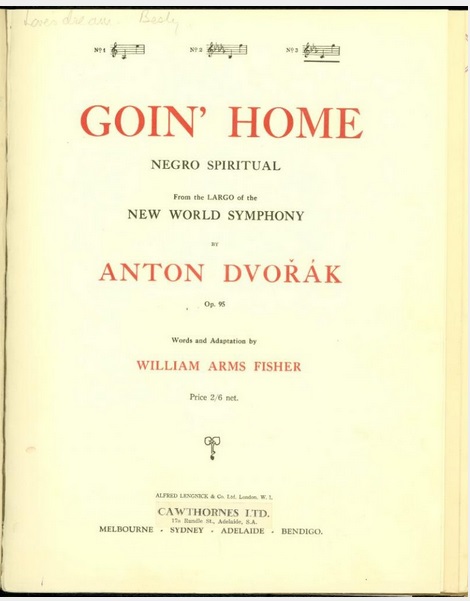
(Note: The Cherry Creek Chorale in the Denver area will be performing this lovely piece in its “American Songbook V” concerts on May 17 and 18, 2024. If you live in the area, make your plans to attend! Tickets may be purchased on this page or at the door.)
Haven’t you vaguely always understood that the second movement of Dvořák’s “New World” symphony was based on an American folk tune? I sure have. Turns out that, like most vague understandings, it’s not true. Dvořák wrote the tune himself; he said to one inquiring conductor that ““I tried to write only in the spirit of those national American melodies.”1 You can assign some kind of folksy charm to the horn solo in Movement #2, but it’s not necessarily American charm:
It has been said that Dvořák’s themes in his symphony were inspired by American folk melodies, especially Afro-American. But his themes are just as similar to Czech or Bohemian folk music and probably came from his own country’s music tradition.2
So all of that is well and good, but my focus in this post is on the words to the song that were written using that horn solo theme in the “Largo” movement. Such a reputable outlet as National Public Radio says that the words were written by Harry Burleigh, a Black composer whom Dvořák befriended while in New York. But they were actually written by another American protégé of Dvořák, a student of his named William Arms Fisher, who was White but who chose to write the lyrics in what he perceived to be some sort of African-American dialect. (Note my somewhat skeptical tone here.) So it’s “jes” instead of “just” and “’spectin’” rather than “expectin’” or “expecting.” And “goin’” is written as “gwine.”
As the song became more popular and mainstream, the dialect was considerably softened or omitted. In fact, although I haven’t been able to find a reproduction of the full original sheet music, I did find an image of the first page, which says at the bottom: “When desired the text may be sung without dialect.”
Here’s what Fisher himself had to say about African-American spirituals in general, in an introduction to an anthology of spirituals that he produced:
Given an ingenuous native capacity for rhythmic musical expression, the gift of improvisation, a primitive but intense emotionalism, a condition of life that ranged from the most naïve light-heartedness to tragic somberness, and an utter dependence for consolation upon faith in invisible realities, often tinged with lingering elements from a barbaric past, and you have that truly unique product – the Spiritual with its background of torch-lit groves, swaying bodies and half-closed eyes.3
A bit much in the way of stereotypes, wouldn’t you say? Fisher was probably remembering Dvořák’s encouragement to his American students: “I am now satisfied that the future music of this country must be founded upon what are called the negro melodies…”4 Fisher (and also probably Dvořák) had never really met anyone who’d been enslaved; he was going on secondhand ideas.
True spirituals are in the category of folk music, which has as its main characteristic that there is no known author and that the song was passed down orally for some time before being written and published. If you’re interested in further reading on the subject I’d recommend another post on this blog, “How Did We Get African-American Spirituals?”5 It’s doubtful that Fisher made that distinction, though, And the song isn’t labeled that way today.
Whatever the reasons were that Fisher decided to label his piece as a “spiritual,” the creative roots of the song are pretty clear: he said that the opening notes of the symphony’s theme suggested the words “goin’ home” to him, and that the rest of the lyrics soon followed. I think that he was taking the advice of his mentor and teacher in all good faith, both in the individual song and also his anthology, but he lacked a true understanding of the people who originally sang those songs, instead thinking of them as exotic, primitive and barbaric. As you can see from the image at the beginning of this post, the original title page for the song specifically says that it is a “Negro spiritual.” Fisher felt comfortable labeling his own song as a spiritual when it was really nothing of the kind.
In the end, though, a piece of music has to be judged on its own merits. What we have now are original lyrics set to an original tune, resulting in a song of true merit. No one can argue with that! And here’s a lovely performance by one of my favorite groups, VOCES8. I’m always amazed at how much sound just these eight singers can produce. The arrangement itself incorporates thematic material from the symphony. It’s great!
copyright Debi Simons
- “New World Symphony—work by Dvořák” in Britannica ↩︎
- “The Story of ‘GOIN’ HOME’–From Bohemia to Boston” ↩︎
- https://pages.stolaf.edu/americanmusic/2017/10/24/william-arms-fishers-goin-home-somehow-a-negro-spiritual/ ↩︎
- “Dvořák on Spirituals” ↩︎
- https://www.debisimons.com/how-did-we-get-african-americanspirituals/ ↩︎

